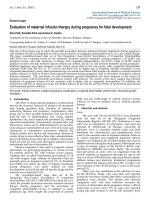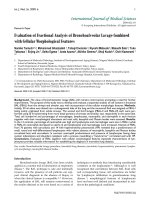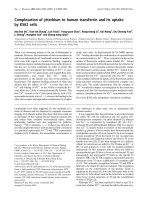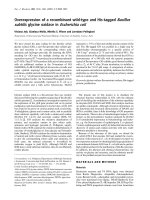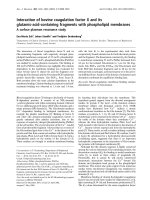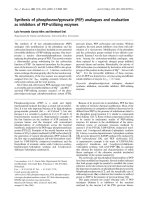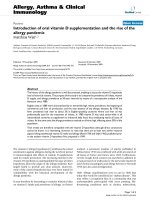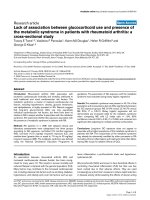Báo cáo y học: "Evaluation of the Prevalence of Concomitant Idiopathic Cyclic Edema and Cellulit"
Bạn đang xem bản rút gọn của tài liệu. Xem và tải ngay bản đầy đủ của tài liệu tại đây (219.31 KB, 3 trang )
Int. J. Med. Sci. 2011, 8
453
I
I
n
n
t
t
e
e
r
r
n
n
a
a
t
t
i
i
o
o
n
n
a
a
l
l
J
J
o
o
u
u
r
r
n
n
a
a
l
l
o
o
f
f
M
M
e
e
d
d
i
i
c
c
a
a
l
l
S
S
c
c
i
i
e
e
n
n
c
c
e
e
s
s
2011; 8(6):453-455
Research Paper
Evaluation of the Prevalence of Concomitant Idiopathic Cyclic Edema and
Cellulite
José Maria Pereira de Godoy
1
, Maria de Fátima Guerreiro de Godoy
2
1. Department of Cardiology and Cardiovascular Surgery and Professor of postgraduate course of Medicine, School of São
Jose do Rio Preto-FAMERP and Research CNPq (National Council for Research and Development), Brazil
2. Occupational therapist, Professor of postgraduate course on Lymphovenous Rehabilitation –FAMERP, Clinic Godoy in
São José do Rio Preto and Research CAPES (Coordination of Improvement of Personal of Superior Level), Brazil
Corresponding author: José Maria Pereira de Godoy, Rua Floriano Peixoto, 2950. São José do Rio Preto, SP – Brazil. CEP:
15010-020. E-mail:
© Ivyspring International Publisher. This is an open-access article distributed under the terms of the Creative Commons License (
licenses/by-nc-nd/3.0/). Reproduction is permitted for personal, noncommercial use, provided that the article is in whole, unmodified, and properly cited.
Received: 2011.02.17; Accepted: 2011.03.28; Published: 2011.08.02
Abstract
The aim of this study was to evaluate the prevalence of concomitant idiopathic cyclic
edema with Grade II and III cellulite. All patients treated for Grade II and III cellulite
were evaluated for idiopathic cyclic edema in a retrospective, quantitative and
cross-sectional study. The study was carried out at the Godoy Clinic in the period from
2006 to 2010. All patients with body mass indexes > 25, Grade I cellulite and other causes
of edema were excluded. The diagnosis of idiopathic cyclic edema was based on a clinical
history and fluid retention throughout the day, in particular difficulty in removing rings
on waking in the morning which improves later in the day. All patients with cyclic
edema were treated with 75 mg aminaphtone three times daily. Statistical analysis con-
sidered the frequency of edema.
Of the 82 women evaluated with ages between 18 and 58 years old (mean of 34.9 years)
41 (50.0%) were diagnosed with idiopathic cyclic edema.
Idiopathic cyclic edema is an aggravating factor for cellulite and is frequently associated
with the more advanced stages of the disease. Its control is essential in the treatment of
cellulite.
Key words: Cellulite, idiopathic cyclic edema, aminaphtone, treatment
Introduction
Cellulite is a common complex cosmetic problem
for many post-adolescent women characterized by
relief alterations of the skin surface, which give the
skin an orange-peel appearance
1
.
It has been demonstrated that the angiotensin
I-converting enzyme (ACE) and hypoxia-inducible
factor-1 alpha (HIF1A) genes play an independent
role in predisposing to cellulite. This may provide
novel information on the pathophysiology of this
common cosmetic problem and offer a research topic
for novel beautification interventions
2
.
Glycosaminoglycans (GAGs) have hydrophilic
properties, which lead to excessive fluid retention in
the dermis, adipocytes, and interlobular septae.
Edema can also lead to vascular compression, hy-
poxia, and capillary neoformation, resulting in mi-
crohemorrhages that are noted upon histologic eval-
uation
3,4
.
Ivyspring
International Publisher
Int. J. Med. Sci. 2011, 8
454
Studies suggest that one pathophysiological
hypothesis on the development of cellulite relates to
interference in the lymphatic system and stimulation
to produce substances in the interstitial space. This
results in regional lymphostasis in the skin which
impedes the mobilization of these substances leading
to their accumulation. Among the factors that affect
this system are female hormones and genetic predis-
position
5
. Clinical studies employing a specific tech-
nique to stimulating the lymphatic system can lead to
the reduction of these substances
6
.
Cellulite can be divided into three main grades
based on the clinical severity. Grade I is characterized
by smooth skin without any dimpling upon standing
and laying down, but the skin adopts a mattress-like
(orange peel) configuration upon pinching, which
forces the fat into the reticular and papillary dermis.
In grade II cellulite, a mattress-like appearance of
cellulite is present upon standing but disappears
when the patient is in the supine position. Grade III
cellulite can be found in patients that exhibit skin
dimpling upon standing and while they are in the
supine position, which can be exacerbated by pinch-
ing the skin
7
.
In recent years an investigation of idiopathic cy-
clic edema began to be routine before starting treat-
ment of cellulite.
Idiopathic cyclic edema syndrome was identi-
fied in 1955 by Mach and is related to a set of clinical
states that involve vascular hyperpermeability asso-
ciated with swelling due to retention of interstitial
fluid
8,9
.
The aim of this study was to evaluate the prev-
alence of concomitant idiopathic cyclic edema and
Grade II or III cellulite.
Method
All patients treated for Grade II and III cellulite
based on the Nurnberger–Muller scale
7
and idio-
pathic cyclic edema were evaluated in a retrospective,
quantitative and cross-sectional study. The study was
carried out at the Godoy Clinic in the period 2006 to
2010.
All patients who sought the clinic with com-
plaints of any type of venous disease and had associ-
ated diagnoses of cellulite were included in the study.
Patients with body mass indexes > 25, Grade I
cellulite and other causes of edema were excluded.
An evaluation for idiopathic cyclic edema is
routinely made in the diagnosis of cellulite, in obesity
and in other evident causes of clinical edema.
The diagnosis of idiopathic cyclic edema was
clinical based on the clinical history and fluid reten-
tion throughout the day and, in particular, difficulty
to remove rings on waking in the morning which im-
proves later in the day. Some patients reported facial
edema early in the morning and swelling of the legs at
the end of the day. Participants were asked to weigh
themselves using the same weighing scales at around
7 a.m. and 7 p.m. for three consecutive days. They
were requested to use the same clothes in both evalu-
ations during each day and not to eat before weigh-
ing. The patient was diagnosed with cyclical edema
when the difference in weight between morning and
afternoon was greater than 800 grams on all three
days.
All patients with cyclic edema were treated with
75 mg aminaphtone three times daily. The treatment
for cellulite began only after controlling the edema
with the weight differences over 12 hours being re-
duced to less than 300 grams.
The frequency of edema was considered in the
statistical analysis. The study was approved by the
Research Ethics Committee of the Medical School in
São José do Rio Preto (FAMERP number 460/2010).
Results
Eighty-two women aged between 18 and 58
years old with a mean age of 34.9 years were evalu-
ated between 2006 and 2010. Of the 82 women, 41
(50.0%) were diagnosed with idiopathic cyclic edema.
The therapeutic approach with aminaphtone was ef-
fective in 32 (72%) patients and the other 9 (28%) re-
quired other types of treatments. Aminaphtone was
the first drug of choice but when treatment failed
ginkgo biloba was prescribed. For the 9 patients
treated with the ginkgo biloba, the treatment of 6 pa-
tients was successful. In 3 patients this was associated
with spironolactone and with the combination of
drugs control of edema was attained.
Discussion
This study illustrates the association of idio-
pathic cyclic edema with more advanced cases of
cellulite. There are no data related to this observation
in the PubMed, ISI and Scopus medical databases.
The identification of this association occurred
from observations of phlebologic and lymphatic pa-
tients. It was observed that some of these patients may
retain significant quantities of fluids throughout the
day. Variations from 800 grams to up to 4 kilos can
occur in patients that drink much liquid throughout
the day. Diagnosis is suggested when there is a dif-
ference of more than 800 grams. However, there are
no additional routine laboratory tests to diagnose this
condition. Thus, diagnosis is clinical with the re-
sponse to treatment using drugs that improve capil-
lary permeability confirming the diagnosis.
Int. J. Med. Sci. 2011, 8
455
The main drug used is aminaftone 75 mg. Alt-
hough, no study has determined the optimal duration
of therapy, it should be maintained for at least six
months, as therapeutic failures have been observed
after short treatment periods. If treatment with
aminaftone fails other options exist with gingko bi-
loba
10
and spironolactone
11
being the main most
commonly used. In the literature dextroamphetamine
sulfate is reported as an option in the treatment of
cyclic edema.
12,13
The treatment of cellulite in this study arose
from reports of patients who were in treatment for
lymphedema using a technique developed by the
authors.
5,6
Some patients recognized that the cellulite,
on the same limb as the lymphedema being treated,
had disappeared. From this observation we started a
line of research into the treatment of cellulite. Thus, all
patients who were referred for treatment of cellulite
were submitted to a detailed vascular assessment,
specifically in relation to edema. The observation of
cyclic edema demonstrated the success of the treat-
ment and the need for its control, but we had no idea
of the high prevalence of edema in the more advanced
grades of cellulite. The lack of specific clinical and
laboratory studies hinders research on cyclic edema
and the dissemination of information on this disease.
The fact that it is idiopathic is another limiting factor
to its management as there are few reports about
treatment in the literature.
During the evaluation of patients with cellulite,
it was noted that many with edema with Grade II and
III cellulite also had idiopathic cyclic edema which
constituted the main reason for treatment failure.
When the idiopathic cyclic edema is not previously
treating, the failure and early relapse rates of treat-
ment for cellulite is more than 80%. Once the edema is
controlled it is possible to obtain better results in the
treatment of cellulite. From this observation patients
are nowadays routinely assessed for cyclic edema
during the evaluation of cellulite; if diagnosed treat-
ment for cellulite is not started until the edema is
controlled.
Another important aspect to be analyzed is the
assessment of all changes that may lead to tissue ac-
cumulation such as in obesity, lipedema and
lymphedema; the pathophysiology of each association
should be addressed in order to improve the aesthetic
result. These associations constitute aggravating ef-
fects such as, for example, cyclic edema aggravates
the symptoms of lipedema, cellulite and obesity.
These data offer a new research perspective in
relation to the treatment of aggravating factors in
cellulite.
Conclusion
Idiopathic cyclic edema is an aggravating factor
for cellulite and is frequently associated with the more
advanced stages. The control of edema is essential in
the treatment of cellulite.
Conflict of Interest
The authors have declared that no conflict of in-
terest exists.
References
1. Terranova F, Berardesca E, Maibach H. Cellulite: nature and
aetiopathogenesis. Int J Cosmet Sci 2006;28:157-67.
2. Emanuele E, Bertona M, Geroldi D. A multilocus candidate
approach identifies ACE and HIF1A as susceptibility genes for
cellulite. JEADV 2010, 24: 930-5
3. Rossi AB, Vergnanini AL. Cellulite: a review. J Eur Acad Der-
matol Venereol 2000;14:251-62.
4. Curri SB. Cellulite and fatty tissue microcirculation. J Cosmet
Toilet 1993;108: 51–58.
5. de Godoy JM, de Godoy Mde F. Physiopathological hypothesis
of cellulite. Open Cardiovasc Med J. 2009;31(3):96-7.
6. Godoy JMP, Almeida EMMZNM, Silva SH, Godoy MFG. Pilot
study of the intensive treatment of cellulite. RBM Especial Clí-
nica Geral 2010; 67:30-2.
7. Mirrashed F, Sharp JC, Krause V, Morgan J, Tomanek B. Pilot
study of dermal and subcutaneous fat structures by MRI in in-
dividuals who differ in gender, BMI, and cellulite grading. Skin
Res Technol 2004;10:161-8.
8. Wold LE, Hines EAJr, Allen EV. Lipoedema of the legs. A syn-
drome characterized by fat legs and edema. Ann Intern Med.
1951 May;34(5):1243-50.
9. Pereira de Godoy JM. Aminaphtone in idiopathic cyclic oedema
syndrome. Phlebology 2008;23(3):118-9.
10. Rostoker G, Behar A, Lagrue G. Vascular hyperpermeability in
nephrotic edema. Nephron. 2000 Jul;85(3):194-200.
11. Ely JW, Osheroff JA, Chambliss ML, Ebell MH. Approach to leg
edema of unclear etiology. J Am Board Fam Med.
2006;19(2):148-60.
12. Check JH, Cohen R, Check D. Idiopathic edema, a condition
associated with pelvic pain and other symptoms in women, as a
remedial cause of chronic cold induced urticaria. Clin Exp Ob-
stet Gynecol. 2010;37(3):235-6.
13. Bhathena SJ, Canary JJ, Smith PM, Glen ML, Gannon CA,
Kennedy BW, Werman MJ. Opioid peptides, adrenocortico-
trophic hormone, and idiopathic (orthostatic) edema. Am J Med
Sci. 1994 Aug;308(2):133-7.


